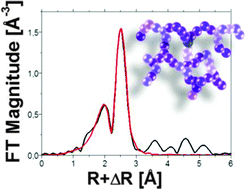Homogeneity and elemental distribution in self-assembled bimetallic Pd–Pt aerogels prepared by a spontaneous one-step gelation process
Abstract
Multi-metallic aerogels have recently emerged as a novel and promising class of unsupported electrocatalyst materials due to their high catalytic activity and improved durability for various electrochemical reactions. Aerogels can be prepared by a spontaneous one-step gelation process, where the chemical co-reduction of metal precursors and the prompt formation of nanochain-containing hydrogels, as a preliminary stage for the preparation of aerogels, take place. However, detailed knowledge about the homogeneity and chemical distribution of these three-dimensional Pd–Pt aerogels at the nano-scale as well as at the macro-scale is still unclear. Therefore, we used a combination of spectroscopic and microscopic techniques to obtain a better insight into the structure and elemental distribution of the various Pd-rich Pd–Pt aerogels prepared by the spontaneous one-step gelation process. Synchrotron-based extended X-ray absorption fine structure (EXAFS) spectroscopy and high-angle annular dark-field (HAADF) scanning transmission electron microscopy (STEM) in combination with energy-dispersive X-ray spectroscopy (EDX) were employed in this work to uncover the structural architecture and chemical composition of the various Pd-rich Pd–Pt aerogels over a broad length range. The Pd80Pt20, Pd60Pt40 and Pd50Pt50 aerogels showed heterogeneity in the chemical distribution of the Pt and Pd atoms inside the macroscopic nanochain-network. The features of mono-metallic clusters were not detected by EXAFS or STEM-EDX, indicating alloyed nanoparticles. However, the local chemical composition of the Pd–Pt alloys strongly varied along the nanochains and thus within a single aerogel. To determine the electrochemically active surface area (ECSA) of the Pd–Pt aerogels for application in electrocatalysis, we used the electrochemical CO stripping method. Due to their high porosity and extended network structure, the resulting values of the ECSA for the Pd–Pt aerogels were higher than that for a commercially available unsupported Pt black catalyst. We show that the Pd–Pt aerogels possess a high utilization of catalytically active centers for electrocatalytic applications based on the nanostructured bimetallic framework. Knowledge about the homogeneity and chemical distribution of the bimetallic aerogels can help to further optimize their preparation by the spontaneous one-step gelation process and to tune their electrocatalytic reactivity.


 Please wait while we load your content...
Please wait while we load your content...